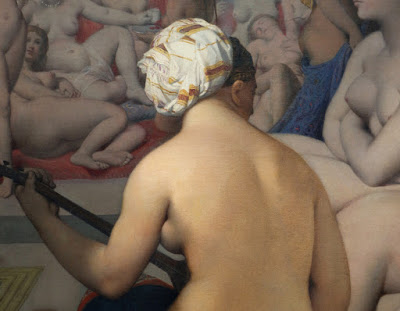 |
| Giulio Carpioni Self Portrait with Turban ca. 1650 oil on canvas Palazzo Pretorio, Prato |
 |
| Jean-Étienne Liotard Mademoiselle Glavani and Monsieur Levett in Turkish Costume ca. 1740 oil on canvas Musée du Louvre |
 |
| Francesco Guardi Interior - A Sultana taking Coffee in the Harem (detail) ca. 1742-43 oil on canvas Art Institute of Chicago |
 |
| Franz Anton Maulbertsch Allegory of Asia ca. 1750 oil on canvas National Gallery, London |
 |
| Gavin Hamilton Thomas Keymer of Kidwelly, à la chinoise 1754 oil on canvas National Trust, Newton House, Carmarthenshire |
 |
| Auguste Couder Mehemet Ali, Viceroy of Egypt 1841 oil on canvas Château de Versailles |
 |
| Jean-Auguste-Dominique Ingres The Turkish Bath ca. 1852-59 oil on canvas Musée du Louvre |
 |
| Jean-Auguste-Dominique Ingres The Turkish Bath (detail) ca. 1852-59 oil on canvas Musée du Louvre |
 |
| Alexandre-Gabriel Descamps Before a Mosque ca. 1868 oil on panel Hermitage, Saint Petersburg |
 |
| Henri Regnault Summary Execution under the Moorish Kings of Granada 1870 oil on canvas Musée d'Orsay, Paris |
 |
| Henri Regnault Summary Execution under the Moorish Kings of Granada (detail) 1870 oil on canvas Musée d'Orsay, Paris |
 |
| Jules-Joseph Lefebvre Odalisque 1874 oil on canvas Art Institute of Chicago |
 |
| Jean Lecomte du Nouÿ Dream of a Eunuch 1874 oil on canvas Cleveland Museum of Art, Ohio |
 |
| Leopoldo Battistini Arab Warrior 1887 oil on canvas Pinacoteca Civica, Palazzo Pianetti, Comune di Jesi |
 |
| Elihu Vedder The Sphinx 1890 oil on canvas Speed Art Museum, Louisville, Kentucky |
"Stimulated by Romanticism's taste for the exceptional and the exotic in human beings and in scenery, as well as the major European nations' growing economic interest in exploiting colonies, a number of mainly French painters took to travelling to North Africa and the Middle East in the 19th century – rarely to the Far East – and to producing works of 'Oriental' history and contemporary life. . . . Orientalist art was welcomed at the Salon but began to lose its hold on the public's taste by the 1880s. The Society of Orientalist Painters, founded in Paris in 1893, was its tombstone. Recent criticism has tended to emphasize the extent to which Orientalism meant the selective exploitation of foreign mores to sustain the Europeans' sense of cultural as well as military superiority."
– Erika Langmuir and Norbert Lynton, Yale Dictionary of Art and Artists (2000)
"The Orient – including present-day Turkey, Greece, the Middle East, and North Africa – exerted its allure on the Western artist's imagination prior to the turn of the nineteenth century. Figures in Middle Eastern dress appear in Renaissance and Baroque works by such artists as Bellini, Veronese, and Rembrandt, and the opulent eroticism of harem scenes appealed to the French Rococo aesthetic. Until this point, however, Europeans had minimal contact with the East, usually through trade and intermittent military campaigns. . . . Some of the first nineteenth-century Orientalist paintings were intended as propaganda in support of French imperialism, depicting the East as a place of backwardness, lawlessness, or barbarism enlightened and tamed by French rule."
– Jennifer Meagher, from an essay on the Heilbrunn Timeline of Art History at the Metropolitan Museum of Art, New York